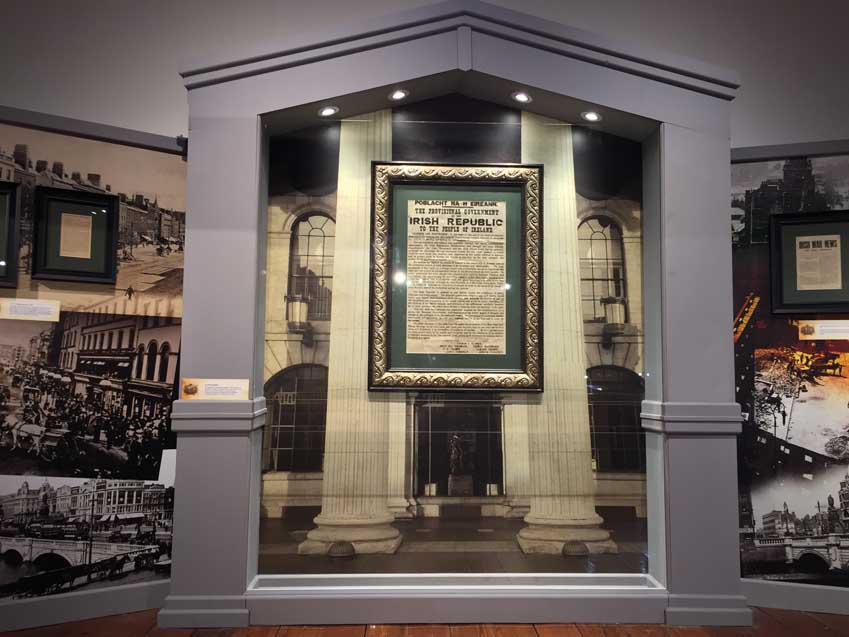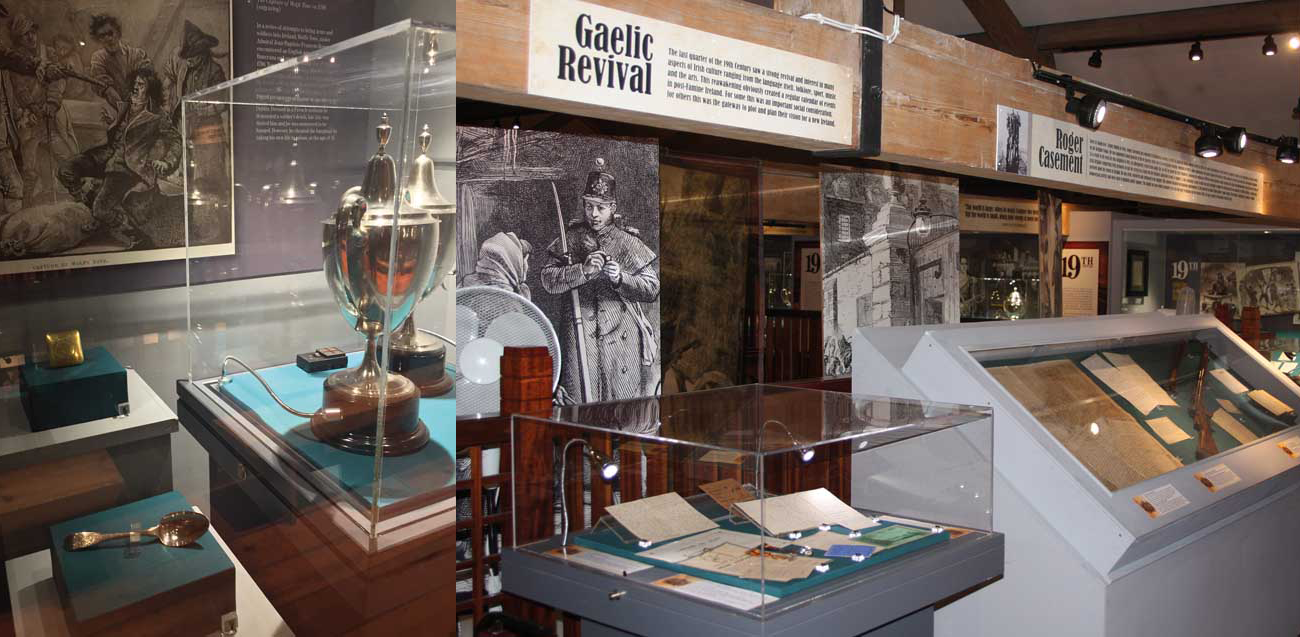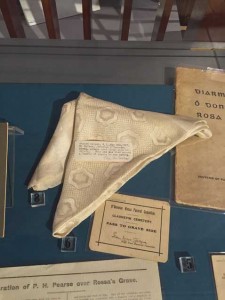BIRTH OF A NATION—THE EVOLUTION OF IRISH NATIONHOOD, 1641–1916’
Published in Issue 1 (January/February 2016), Reviews, Volume 24County Museum,
Jocelyn Street, Dundalk
dundalkmuseum.ie
By Tony Canavan
Dundalk has been quick off the mark in mounting the country’s first exhibition about the 1916 Rising, which was officially opened by Taoiseach Enda Kenny. Situated on the top floor of the museum, it is free to the public.
The exhibition area is rectangular and you go through it clockwise, beginning with the Cromwellian era. One is immediately struck by the enlarged banners, photos and posters which hang around the room, and the clear, calm, disembodied voice reading the Proclamation (there could have been an interval of more than a few seconds between readings, although on the other hand I can now recite the Proclamation by heart). Between the display cases, large panels convey information on the events and set them in context.

The centre-piece of the exhibition is a neo-classical arch, which surrounds an ornately framed original copy of the 1916 Proclamation.
The exhibition situates the 1916 Rising in the historical context of centuries of opposition to British rule. It begins with artefacts related to the Cromwellian era, such as broadside pamphlets, letters and government proclamations. The next cabinet looks at the eighteenth century and the growth of a patriotic movement. Among the objects on display here are a sword from the Drogheda militia and a mess spoon of the Louth militia. This century ended with the United Irishmen’s rebellion of 1798, followed by union with Great Britain.
The next display looks at the nineteenth century, beginning with Robert Emmet’s rebellion in 1803, which is represented by his death-mask, made after his execution. Look out for an impressive silver-plate urn used in a money-raising drive to create a ‘patriotic fund’. Here, too, we take in Daniel O’Connell’s successful campaign for Catholic Emancipation and his failed attempt to repeal the Act of Union, the Great Famine, the Young Irelanders and the Land League. All of this reflects a turbulent century, which also saw the Home Rule campaign. These episodes are represented by letters, posters and other documents, including a ration card from the Famine.
One of the strengths of this exhibition is that it manages to combine the national and the local and this becomes more apparent as it approaches the 1916 Rising, with references to County Louth events and people becoming more frequent. The run-up to the Rising covers the Home Rule crisis. A copy of the anti-Home Rule ‘Solemn League and Covenant’, a recruitment poster for the Irish Volunteers, photographs and even contemporary film footage illustrate the febrile atmosphere surrounding the passing of the Home Rule Act, which of course was shelved on the outbreak of the First World War.

Above left: Trophies awarded to Lord Henry Murray for his role in suppressing the 1798 Rebellion in Coleraine (right);
silver spoon from the Louth Militia (bottom); cross-belt plate, also Louth Militia (left). Above right: Displays highlighting the cultural
renaissance of the late nineteenth and early twentieth centuries.
The growing momentum for a rising is well illustrated with photographs, letters and posters relating to events such as the funeral of O’Donovan Rossa, the Howth and Larne gunrunnings and so on, and there are display cabinets related to the cultural and political organisations active at the time, from the GAA to Inghinidhe na hÉireann. Among the things to look out for are a silk handkerchief that belonged to O’Donovan Rossa and a set of ‘lucky charms’ owned by the veteran Fenian John Devoy.
Prominence is given to Roger Casement, reflecting his humanitarian work prior to 1914 and his negotiations with Germany. There is the map of the Kerry coast that he had with him when he landed there just before the Rising was due to start. His story is carried on through to his execution.
The main focus of the exhibition is the back wall of the gallery. Photos and images display aspects of the events of Easter Week 1916, with two screens running film from the time, much of it new to me. The centre-piece is a neo-classical arch surrounding an ornately framed original copy of the 1916 Proclamation. All this impressively conveys how momentous the Rising was in Irish history.

Items associated with the funeral of Jeremiah O’Donovan Rossa in Glasnevin Cemetery on 1 August 1915, including his silk handkerchief.
Beyond this symbolism, the events of that week are represented by documents such as the ‘Irish War News’ (the rebels’ communiqué from the GPO), a proclamation of martial law by the British authorities and a map showing other places where the Rising took place. A more human face is put on this with an exhibit dedicated to the seven signatories of the Proclamation and Countess Markievicz, with a photograph of each and a brief biography. Of course, the signatories and nine others were all executed. Next to this a display cabinet contains Volunteer and RIC uniforms alongside two Lee Enfield rifles, one used by the RIC, the other by the Volunteers. The exhibition concludes with the Rising’s aftermath.
This is an impressive exhibition that lives up to its ambitious title. It packs a lot in, combining both the local and the national but managing to be coherent, interesting and informative as well. I found myself getting lost in the detail of each display cabinet, whether taking a closer look at medals or trying to decipher letters (a transcript of all letters is available). Not content to rest on its laurels, the museum is already planning another major exhibition on the War of Independence.
Tony Canavan is editor of Books Ireland.
















